Overview
This article highlights the importance of authentic representation of autism in media, particularly through the character Dr. Shaun Murphy, portrayed by Freddie Highmore in "The Good Doctor." Such portrayals are vital as they challenge stereotypes and foster understanding. Viewer feedback reveals that these representations have led to increased empathy and awareness of autistic individuals, promoting a more inclusive society.
As parents, it’s essential to recognize how media influences perceptions of autism. When characters like Dr. Shaun Murphy are depicted authentically, they not only entertain but also educate viewers about the realities faced by those on the spectrum. This understanding can pave the way for conversations about acceptance and support within our communities.
By embracing these narratives, we can collectively contribute to a culture that values diversity and inclusivity. Let’s engage with these portrayals, share our thoughts, and encourage others to do the same. Together, we can foster a more compassionate society that understands and supports autistic individuals.
Introduction
In a world where narratives about autism are often clouded by misconceptions and stereotypes, the importance of authentic representation in media cannot be emphasized enough. Take, for instance, 'The Good Doctor.' Its compelling portrayal of Dr. Shaun Murphy serves as a significant force in reshaping public perceptions of autism. This series not only highlights the challenges faced by individuals on the spectrum but also celebrates their unique strengths and capabilities.
As we delve into the significance of accurate portrayals in media, we see how shows like 'The Good Doctor' foster understanding, empathy, and acceptance within our society. By examining the relationship between media representation and real-world perceptions, it becomes evident that thoughtful narratives can pave the way for a more inclusive future for individuals with autism. Together, we can support these essential conversations and contribute to a world that embraces diversity and understanding.
About ASD Media: Empowering Autism Advocacy and Support
At ASD Media, we are deeply committed to advancing the implementation of Applied Behavior Analysis (ABA) therapy. Our mission is to offer valuable insights and strategies that help overcome challenges and improve outcomes for children and families. We provide a comprehensive array of resources tailored for both parents and professionals in the field, creating a supportive and inclusive community. This environment encourages individuals to share their experiences, learn from one another, and receive essential support throughout their journeys.
By subscribing to our newsletter, members gain access to the latest news and unlimited digital resources, empowering them to unlock the potential of children with developmental disorders and ADHD. We focus on delivering effective strategies for managing challenging behaviors, navigating support services, and enhancing social skills development.
Recent studies underscore the effectiveness of intensive and long-term ABA therapy, revealing significant improvements in:
- Intellectual functioning
- Language development
- Daily living skills
- Social functioning
These findings reinforce ABA therapy's status as an evidence-based best practice, with a notable 46% of children continuing therapy for 24 months. This highlights our commitment to sustained support for families. Additionally, New Jersey has been recognized as the best state for ABA therapists to live, enhancing the professional landscape for those dedicated to this field.
The rewarding nature of a career in ABA therapy is evident, as many professionals find deep satisfaction in helping children achieve their potential. As Steven Zauderer, CEO & Founder, notes, "BACB Certificant Data shows that ABA therapy is effective in supporting positive behavioral skills development."
At ASD Media, our mission is to empower individuals in the advocacy community for developmental disorders, ensuring they have the tools and knowledge necessary to make a meaningful impact. Through our initiatives, we aim to enhance the implementation of ABA therapy and advocate for the needs of those impacted by developmental disorders. We invite you to join us in this important journey.
Realistic Representation: The Impact of Freddie Highmore's Role in 'The Good Doctor'
Freddie Highmore, the good doctor actor autistic, has garnered heartfelt praise for his portrayal of Dr. Shaun Murphy in 'The Good Doctor' due to its depth and authenticity, effectively challenging stereotypes associated with autism. By showcasing a character who is the good doctor actor autistic and also a highly skilled surgeon, the show offers a nuanced perspective that resonates deeply with viewers. Highmore, known as the good doctor actor autistic, has shown dedication to understanding the intricacies of his character, which has fostered increased compassion and awareness of autistic individuals in professional environments.
Notably, 40% of parents express 'strong empathy' for non-verbal autistic individuals with learning disabilities. This statistic underscores the vital role of authentic representation in enhancing comprehension and acceptance within the community, particularly as the good doctor actor autistic exemplifies the potential for success and capability among those on the spectrum.
Case studies illustrate that realistic portrayals in visual narratives can lead to greater acceptance and understanding of individuals on the spectrum. One such case study, titled 'The Influence of Autism Portrayals,' highlights how improving the depiction of individuals with autism in media can create opportunities for deeper understanding and acceptance of the autism community. The impact of Highmore's character has been notably recognized in professional discussions, emphasizing the importance of incorporating diverse perspectives in narratives surrounding autism.
As Wanting Zhou insightfully remarked, 'It is not only families but also multiple voices that should be included in news reports,' reflecting the necessity of varied viewpoints in addressing this condition.
Furthermore, the recent panel at Cannes, featuring insights from experts like Amanda Morris and Dr. Rebecca Swift, reinforces the ongoing conversation about the portrayal of autism in journalism. As this dialogue evolves, the good doctor actor autistic, Highmore, serves as a powerful example of how thoughtful portrayals can contribute to a more inclusive society. To support this mission, it is crucial for audiences to engage with and advocate for authentic representation in media, fostering a deeper understanding of autism and its diverse narratives.
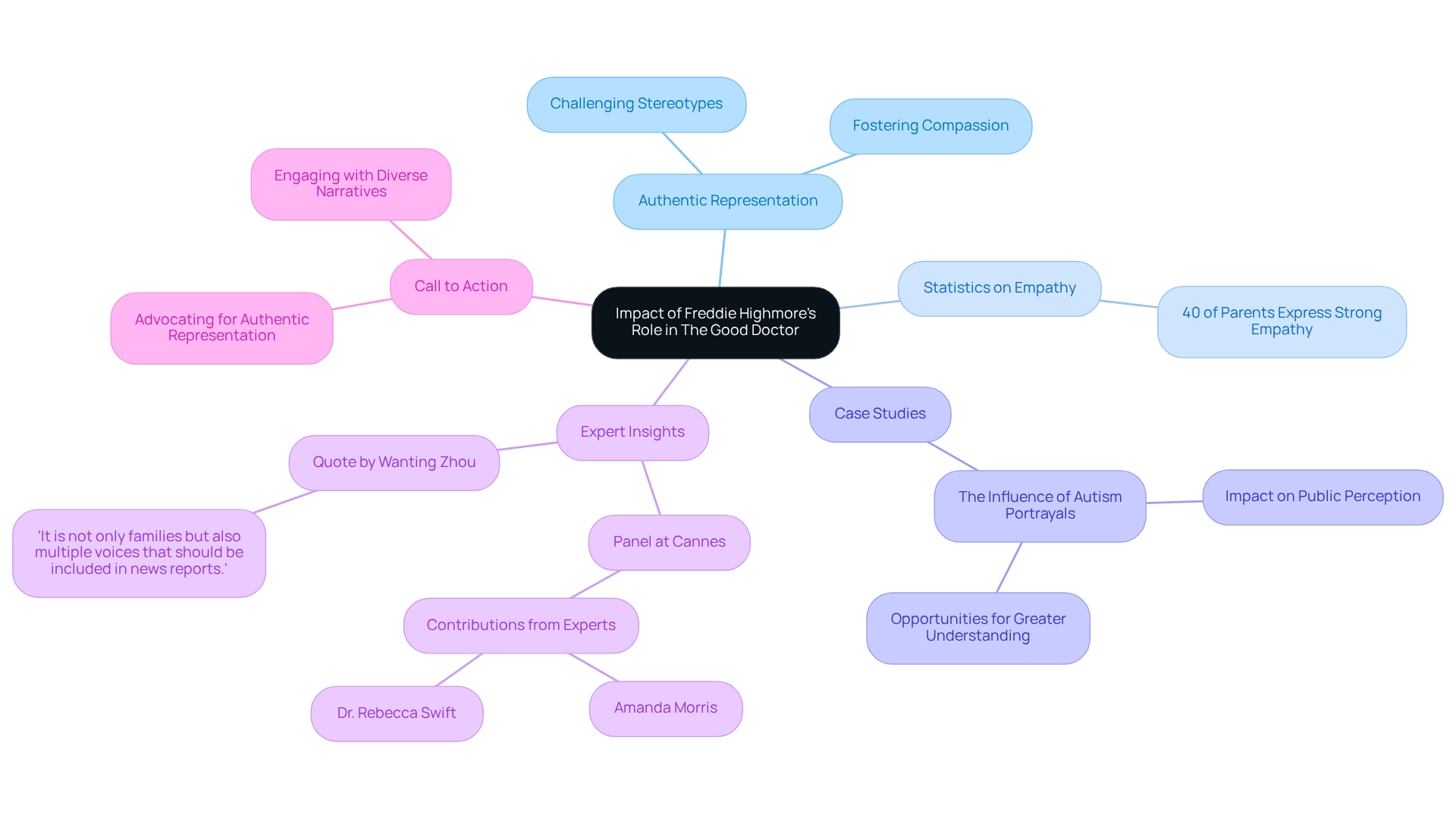
Understanding Challenges: Why Accurate Portrayals of Autism Matter
Accurate representations of autism in media are vital for fostering understanding and acceptance. Misrepresentations can perpetuate harmful stereotypes, while authentic portrayals enlighten the public about the diverse experiences of autistic individuals. For instance, the actor who portrays Dr. Shaun Murphy in 'The Good Doctor' is autistic, highlighting not only the challenges faced by autistic individuals but also their strengths, which encourages a more nuanced conversation about autism. This depiction holds particular significance in 2025, as misconceptions about autism continue to thrive; research indicates that many still associate autism solely with severe disabilities, overlooking the wide range of skills and experiences present in the community.
In fact, according to the U.S. Department of Education, 8% of autistic students in the U.S. do not finish high school, compared to 5% of all students, illustrating how societal misconceptions can adversely affect educational outcomes. Psychologists stress that accurate portrayals can profoundly influence societal attitudes, aiding in the dismantling of stigma and fostering acceptance. As one psychologist noted, "Media portrayals influence our comprehension of the condition and can either reinforce damaging stereotypes or encourage a more inclusive viewpoint."
Moreover, case studies reveal that media distortion can lead to tangible real-world effects, such as reduced opportunities for autistic individuals in education and employment. For example, the typical costs of services for individuals with developmental disorders in the U.S. vary significantly, with adaptive behavior services averaging around $82.25 and emergency department visits estimated at approximately $1,397.22. These figures underscore the financial consequences stemming from inadequate support, often due to misrepresentation.
By showcasing genuine stories, media can play a transformative role in shaping perceptions and improving the lives of individuals with autism-related conditions. Connecting data sources is equally essential for understanding the experiences of the autistic community and enhancing service delivery. Together, we can work towards a more informed and compassionate society.
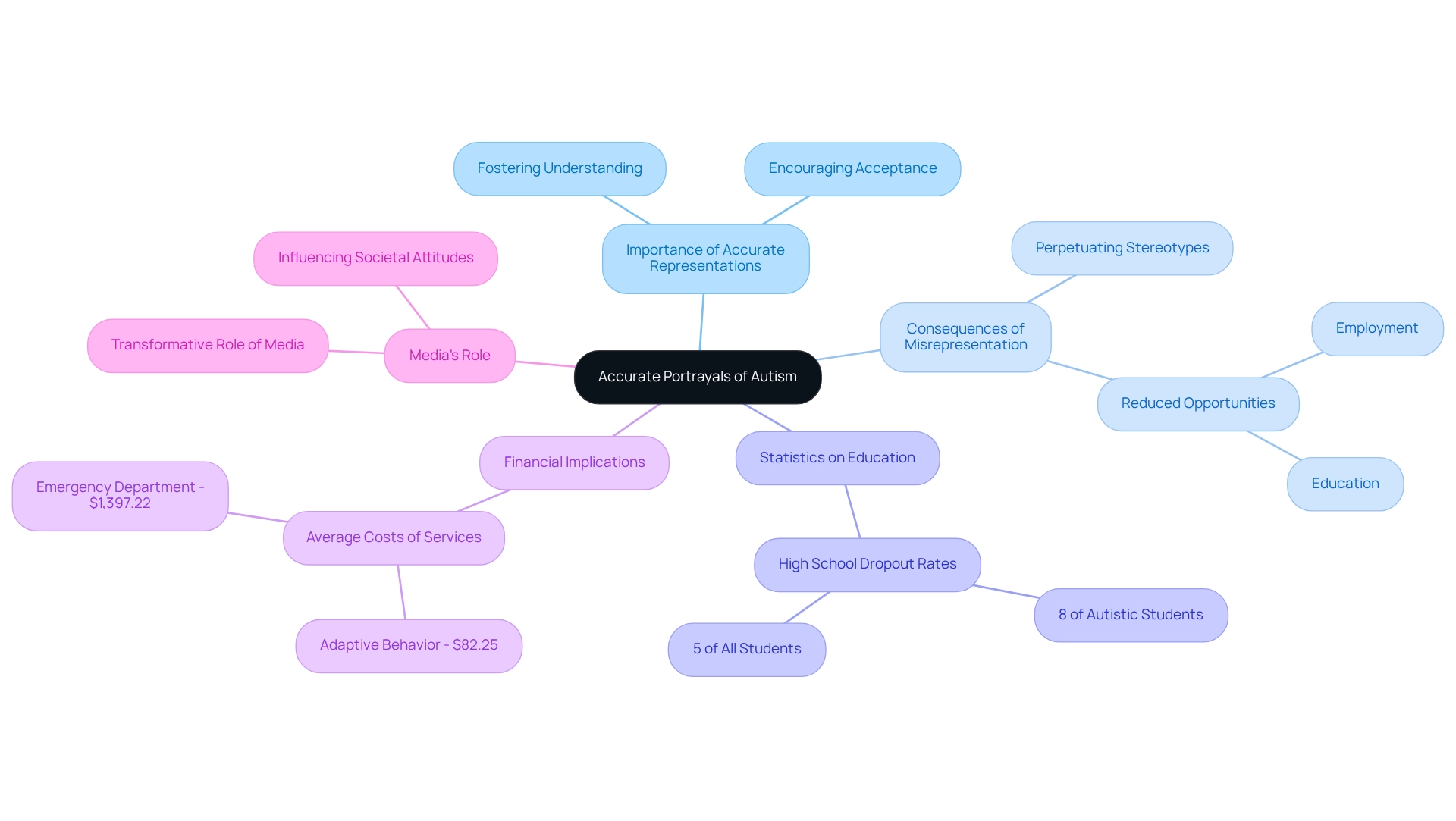
Promoting Awareness: The Role of 'The Good Doctor' in Autism Education
The Good Doctor' serves as a vital platform for raising awareness about autism spectrum disorder, with the good doctor actor autistic playing a key role in seamlessly weaving educational elements into its storyline. By showcasing the varied experiences of individuals on the spectrum, including the good doctor actor autistic, the series effectively highlights both their challenges and triumphs. This narrative approach not only deepens our understanding of the condition but also sparks important conversations in various social settings.
Recent surveys indicate that viewers report a greater comprehension of autism after watching the show, underscoring its educational impact. Moreover, educators emphasize the media's role in shaping perceptions of autism, noting that the good doctor actor autistic can significantly enhance public awareness and empathy through programs like 'The Good Doctor'.
As Dena Gassner, an adjunct professor at Towson University, observes, families often seek assistance from systems like Social Security during their most challenging times, revealing the urgent need for improved understanding and support. By portraying the unique traits of autism spectrum disorder, similar to the good doctor actor autistic, the series contributes to cultivating a more informed and compassionate community, ultimately fostering greater acceptance of individuals with this condition in society.
Furthermore, with the average cost of therapeutic behavioral services in the U.S. being $175.44, the financial burden of care for individuals on the spectrum is substantial, making the show's educational narrative even more pertinent for parents advocating for their children. The series not only entertains but also informs, paving the way for tailored interventions that recognize the individuality of each person on the spectrum.
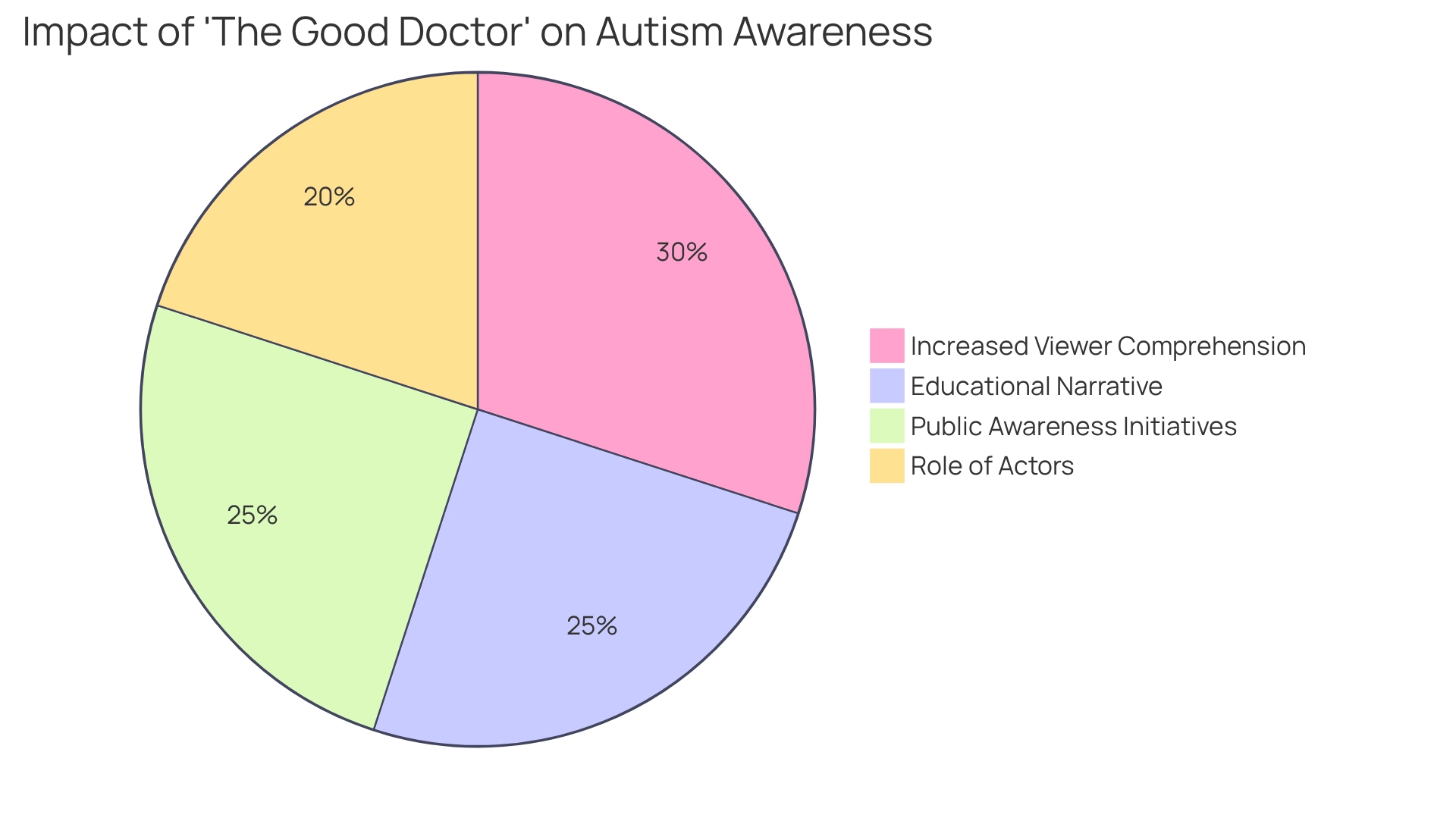
Critical Acclaim: The Societal Impact of 'The Good Doctor' on Autism Perception
The Good Doctor' has garnered significant critical acclaim for its thoughtful portrayal of autism, particularly highlighting the good doctor actor autistic representation, with many reviewers praising its nuanced approach. This series has sparked vital discussions about the strengths and challenges faced by individuals on the spectrum, illuminating the diversity within autism and celebrating the unique abilities of autistic individuals. Such a positive representation is crucial in reshaping societal perceptions, as it humanizes autistic persons and highlights their capabilities.
Research indicates that portrayals in media can profoundly influence public perceptions; thus, the impact of 'The Good Doctor' is particularly noteworthy. Critics have observed that the show promotes a more inclusive society by fostering understanding and acceptance of those on the spectrum. Additionally, ongoing studies suggest that increased visibility of autism in popular media is linked to a reduction in stigma, underscoring the importance of accurate and compassionate portrayals.
For instance, Fei-Fan Pang's research shows a significant correlation between teachers' knowledge of ASD and their attitudes and professional self-efficacy regarding children with ASD, illustrating how informed portrayals can shape perceptions. However, while Shaun's character navigates social interactions and communication challenges, the show simplifies these difficulties by placing him in a high-pressure hospital environment, which may not accurately reflect the reality for many autistic individuals. This simplification can lead to an oversimplified or sensationalized view of the condition, failing to capture the complexities of real-life experiences faced by autistic people.
As conversations around developmental disorders evolve, the good doctor actor autistic emerges as a pivotal influence in nurturing a more informed and compassionate perspective on these conditions. Parents are encouraged to engage with the show by discussing its themes with their children, reinforcing the essential message of understanding and acceptance.
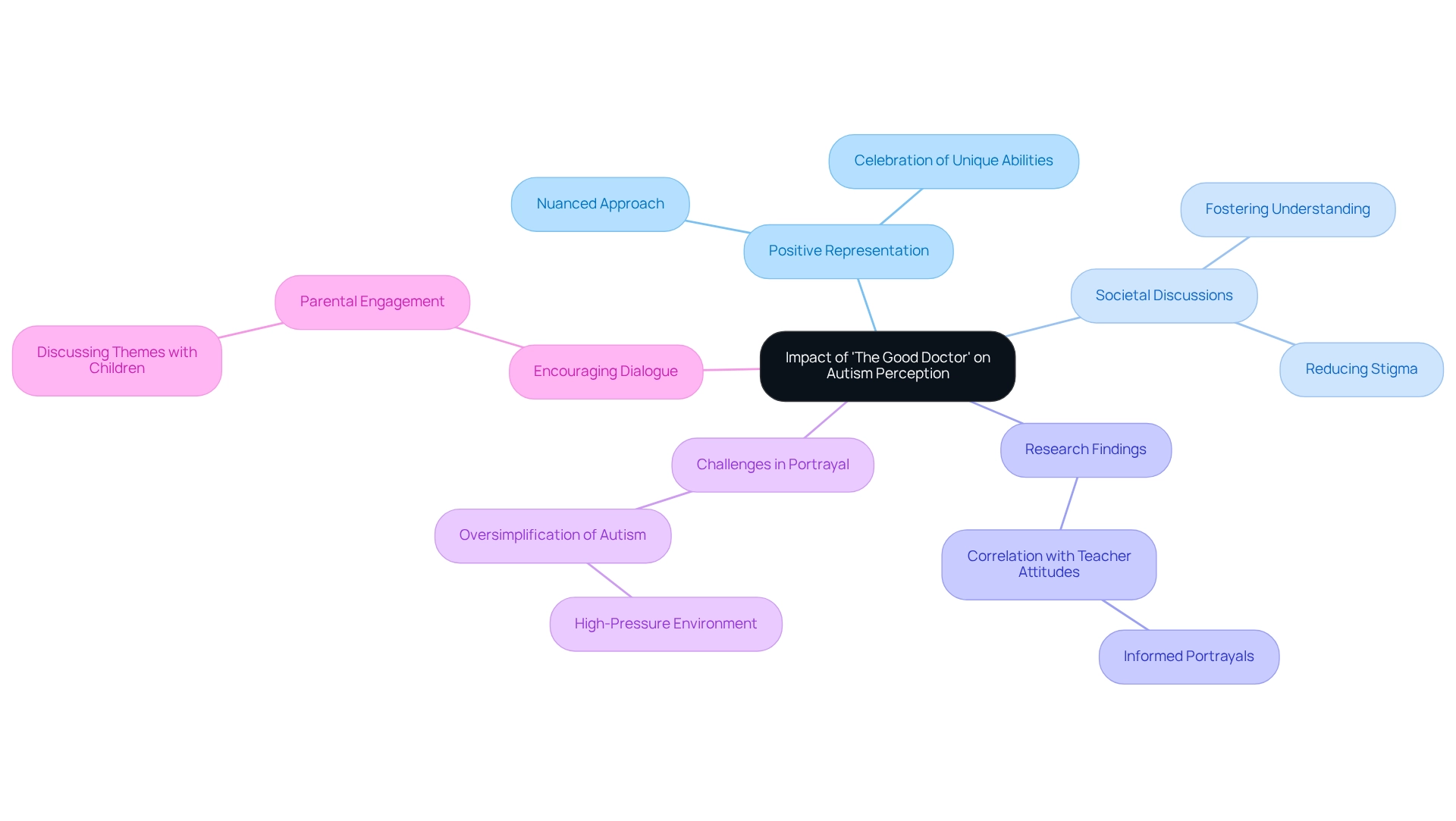
Character Development: Freddie Highmore's Preparation for Authentic Autism Portrayal
Freddie Highmore's preparation for his role as the good doctor actor autistic Dr. Shaun Murphy in 'The Good Doctor' exemplifies a heartfelt commitment to authenticity in depicting autism. His thorough research, which included working closely with specialists and individuals on the spectrum, ensures a nuanced representation that resonates deeply with viewers, much like the good doctor actor autistic. The good doctor actor autistic demonstrates dedication in his performance, effectively conveying the complexities of the condition in a relatable manner. Highmore's approach underscores the vital role of preparation in accurately representing marginalized communities in media. Research shows that actors who invest time in understanding the experiences of those they portray can significantly enhance the authenticity of their performances. Such efforts not only lead to more accurate depictions but also foster greater awareness and understanding among audiences, ultimately promoting a more inclusive narrative around autism.
Yet, the performing arts sector still faces systemic challenges. A statistic reveals a concerning lack of diversity among employers, with none including individuals with intellectual disabilities. This reality further emphasizes the significance of genuine portrayal in media. Additionally, a poignant case study titled 'Desire for Greater Understanding' highlights the need for increased awareness and collaboration between autistic professionals and their non-autistic colleagues.
Pro M's powerful quote, 'I’m not shy about coming forward and saying, 'I’m autistic. This is what I need,' reinforces the importance of understanding the needs of autistic individuals. Finally, the call for longitudinal studies to examine various exposures to different fictional media depictions sheds light on the broader implications of media portrayal and its effects on public perception.
Community Feedback: Autism Advocacy Perspectives on Media Portrayals
Feedback from the neurodivergent community regarding 'The Good Doctor' reveals a spectrum of opinions that resonate deeply. Many viewers commend the series for its sincere efforts to portray autism, recognizing the positive impact that such visibility can have on public understanding. Yet, there are significant concerns about the oversimplification of autistic experiences, which risks perpetuating stereotypes and failing to capture the true complexity of living with the condition.
Advocacy groups emphasize the necessity for more nuanced portrayals that reflect the diverse experiences within the autistic community. For instance, 'KFM Making a Difference,' founded by Kerry Magro, highlights the importance of educational support for adults with developmental differences, advocating for portrayals that truly connect with their experiences. Kerry Magro shared, "I established a nonprofit to raise awareness about neurodiversity and assist students with developmental disorders in obtaining scholarships for college," underscoring the need for accurate representation in media.
As discussions around neurodiversity evolve, it becomes increasingly vital for media to include a broader array of perspectives, ensuring that depictions are not only precise but also encompass the rich tapestry of experiences of individuals on the spectrum. Statistics indicate that community voices are becoming more vocal about the necessity for authenticity in media representations, emphasizing the role of 'The Good Doctor' and the good doctor actor autistic in shaping societal views on developmental disorders.
Additionally, the challenges posed by COVID have hindered progress in accurately depicting individuals on the spectrum, making it even more essential for productions to strive for authenticity and depth in their portrayals. The impact of 'The Good Doctor' could set a new standard for future media representations of individuals on the autism spectrum, highlighting the importance of thoughtful and informed storytelling.
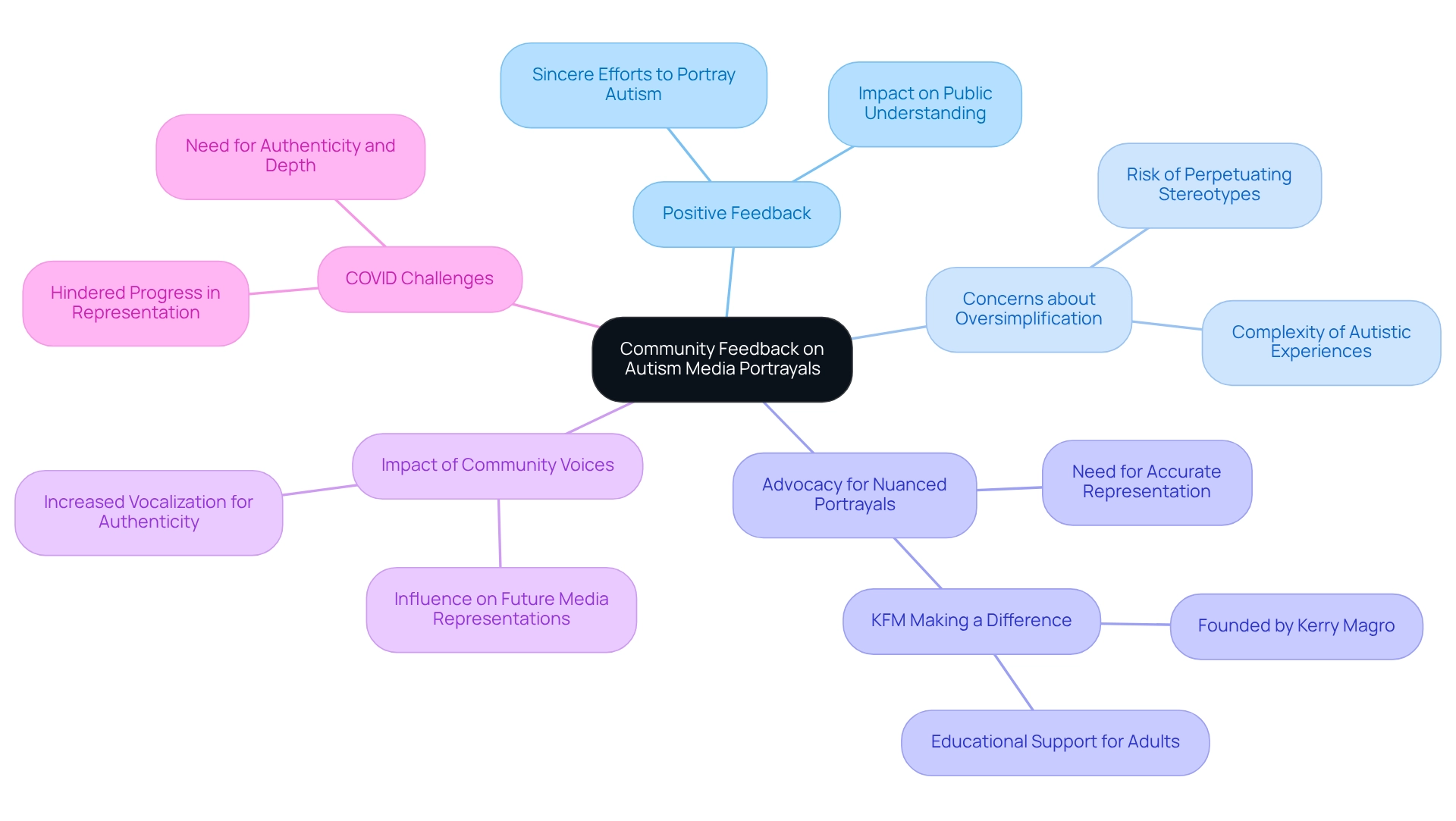
Comparative Analysis: 'The Good Doctor' vs. Other Media Representations of Autism
The Good Doctor' features the good doctor actor autistic, who stands out in the realm of developmental disorder representations by centering on a complex lead character that adeptly navigates both personal and professional challenges. Unlike many portrayals that lean heavily on stereotypes, this series provides a more nuanced depiction of the condition, particularly in the way the good doctor actor autistic showcases the character's strengths alongside their vulnerabilities.
Recent studies indicate that diverse representations can help rectify misunderstandings and foster deeper insights among viewers. A non-autistic family member noted, "Many relatives, friends, and coworkers have mentioned the program has aided them in comprehending the condition better," underscoring the show's vital role in enhancing awareness of the disorder. This feedback emphasizes the importance of authentic storytelling in communication, which not only enriches representation but also has the potential to positively influence societal perceptions of individuals on the autism spectrum, such as the good doctor actor autistic.
Additionally, while 'The Good Doctor' effectively addresses various misconceptions, it is essential to recognize the possible negative impacts of stereotypical portrayals. Some participants expressed concerns that Sam's depiction might inadvertently reinforce stereotypes associated with individuals on the spectrum.
As we reflect on 'The Good Doctor' alongside other representations, it becomes clear that nuanced portrayals are crucial for nurturing empathy and awareness, ultimately leading to a more informed public dialogue about neurodiversity.
Inclusivity in Media: Enhancing Understanding of Autism Through Diverse Portrayals
Inclusiveness in communications plays a crucial role in enhancing our understanding of conditions on the autism spectrum. By showcasing diverse representations of autistic individuals, media can effectively challenge prevailing stereotypes and foster wider acceptance. For instance, shows like 'The Good Doctor' highlight the good doctor actor autistic, exemplifying how to weave a variety of experiences and perspectives into their narratives, creating a more inclusive storyline that resonates with a broader audience. Studies reveal that varied portrayals not only enhance audience acceptance but also contribute to a more nuanced understanding of the condition, which is vital for promoting empathy and support within our communities.
As highlighted by the ADDM Network, the occurrence of the spectrum condition among 8-year-olds was noted as 1 in 68 in 2012, underscoring the importance of accurate portrayal in media. Furthermore, case studies, such as 'Impact of ASD on Families and Communities,' demonstrate that when media authentically reflects the complexities of the condition, it can lead to increased awareness and advocacy, ultimately benefiting individuals and families affected by ASD. As we move toward 2025, the call for more inclusive portrayals in media remains essential, allowing viewers to connect with and understand the diverse experiences of those on the spectrum. Additionally, broadening the depictions of individuals on the autism spectrum in media can help dispel misconceptions about the condition, reinforcing the necessity for inclusive portrayals.
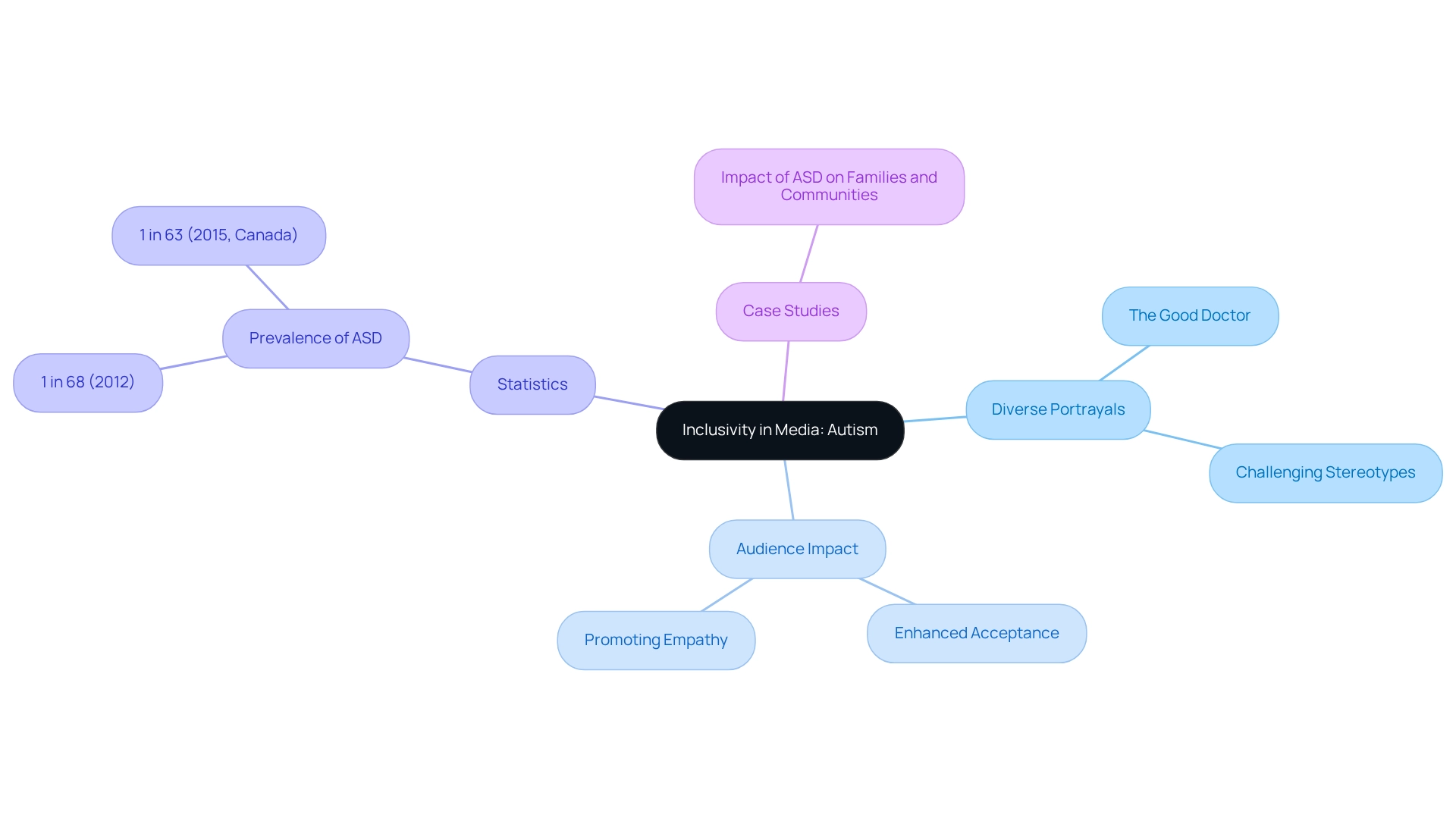
Ongoing Dialogue: The Future of Autism Representation in Television and Film
The future of representation for individuals on the spectrum in television and film hinges on a vital conversation that genuinely includes the perspectives of the autistic community and their advocates. As the industry increasingly prioritizes authenticity and inclusivity, it is essential for creators to actively involve autistic individuals in the storytelling process. This collaborative approach not only fosters more accurate and thoughtful representations but also enriches the media landscape, promoting a deeper understanding of autism.
For instance, case studies like Rosie King's showcase her unique visual thinking abilities, illustrating how those on the spectrum can contribute invaluable insights to storytelling. Furthermore, statistics reveal that as awareness grows, so too does the representation of individuals on the autism spectrum in media; notably, the prevalence of such conditions in South Africa has reached 1 in 160, underscoring the urgent need for accurate portrayal.
Engaging with the autistic community is not merely advantageous; it is essential for crafting narratives that resonate and authentically reflect the realities of those they aim to depict. As highlighted by the Centers for Disease Control and Prevention, the rising prevalence of autism emphasizes the necessity of collaboration with autistic individuals to ensure their stories are told with authenticity.
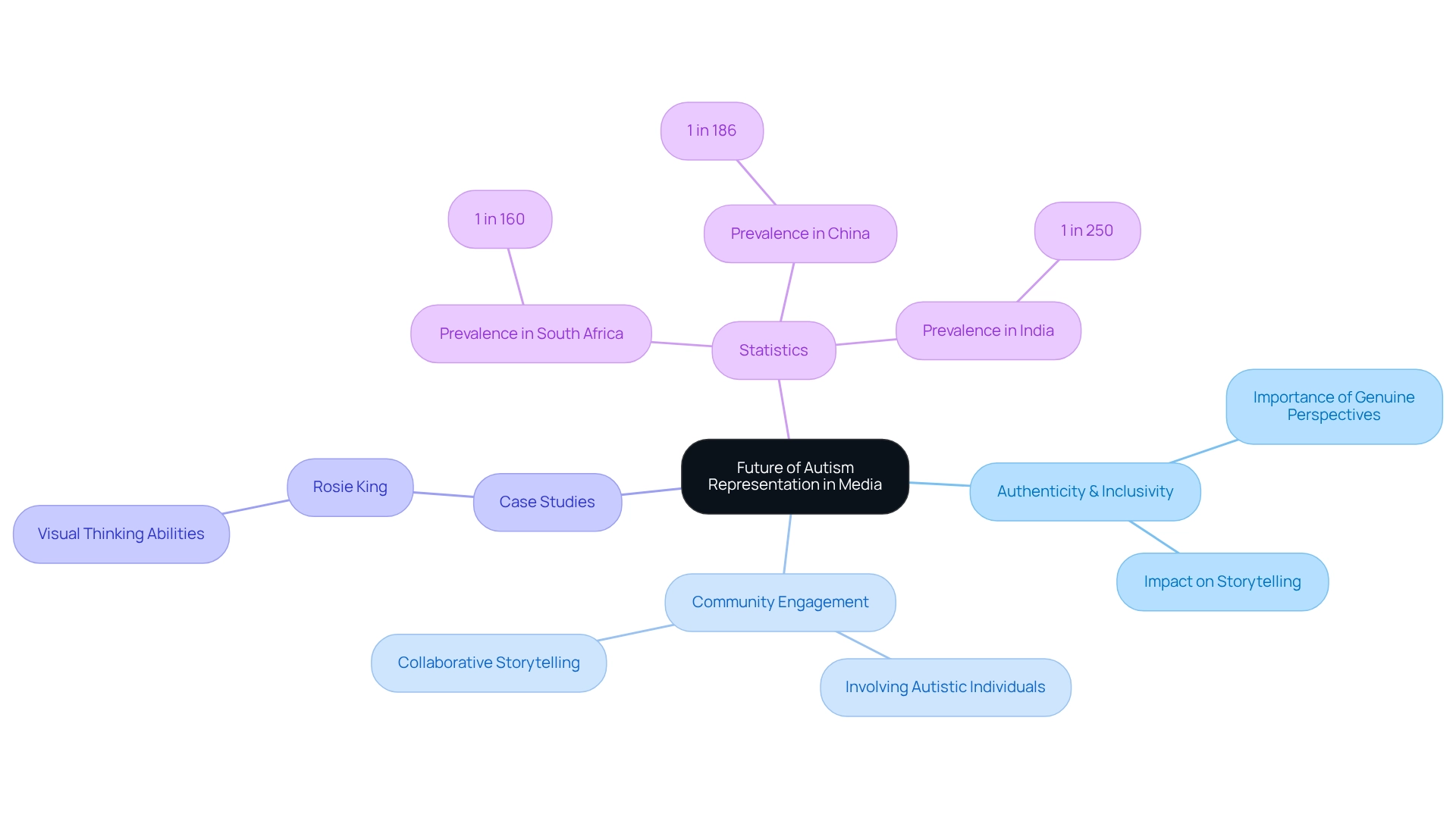
Conclusion
Authentic representation of autism in media transcends mere storytelling; it serves as a powerful catalyst for reshaping societal perceptions and nurturing greater understanding. 'The Good Doctor' exemplifies how thoughtful portrayals can challenge stereotypes and illuminate the diverse experiences of individuals on the autism spectrum. Through the character of Dr. Shaun Murphy, the series adeptly navigates the complexities of autism, revealing both the struggles and unique strengths that autistic individuals embody.
The significance of accurate representation is profound. Research shows that media portrayals greatly influence public attitudes, fostering increased empathy and awareness. Yet, as feedback from the autism community highlights, it is crucial that these portrayals remain nuanced and reflective of real-life experiences. Oversimplification risks perpetuating harmful stereotypes, emphasizing the necessity for diverse voices in the narrative.
As our society advances in its understanding of autism, the role of media becomes ever more essential. Collaborating with the autistic community in the storytelling process can yield more authentic and respectful portrayals, paving the way for a future where individuals on the spectrum are not only understood but celebrated for their contributions. Ultimately, cultivating a culture of inclusivity in media is vital for dismantling misconceptions and promoting acceptance, fostering a more compassionate society for everyone. Let us work together to create a world where every voice is heard and valued.
Frequently Asked Questions
What is the mission of ASD Media?
ASD Media is committed to advancing the implementation of Applied Behavior Analysis (ABA) therapy, offering insights and strategies to improve outcomes for children and families. They provide resources for both parents and professionals, fostering a supportive community.
What resources does ASD Media offer?
ASD Media offers a comprehensive array of resources tailored for parents and professionals, including access to the latest news and unlimited digital resources to help manage challenging behaviors, navigate support services, and enhance social skills development.
What recent studies have shown about ABA therapy?
Recent studies indicate that intensive and long-term ABA therapy leads to significant improvements in intellectual functioning, language development, daily living skills, and social functioning. About 46% of children continue therapy for 24 months, reinforcing its effectiveness as an evidence-based best practice.
Why is New Jersey recognized in the context of ABA therapy?
New Jersey has been recognized as the best state for ABA therapists to live, enhancing the professional landscape for those dedicated to the field.
What is the impact of Freddie Highmore's portrayal of Dr. Shaun Murphy in 'The Good Doctor'?
Freddie Highmore's portrayal of Dr. Shaun Murphy, who is autistic, has been praised for its depth and authenticity, challenging stereotypes associated with autism and fostering compassion and awareness in professional environments.
What percentage of parents express strong empathy for non-verbal autistic individuals?
Approximately 40% of parents express 'strong empathy' for non-verbal autistic individuals with learning disabilities, highlighting the importance of authentic representation in enhancing understanding and acceptance.
How can media portrayals of autism influence societal attitudes?
Accurate representations of autism in media can foster understanding and acceptance, while misrepresentations can perpetuate harmful stereotypes. Realistic portrayals can lead to greater acceptance and create opportunities for deeper understanding of individuals on the spectrum.
What are the educational outcomes for autistic students compared to all students?
According to the U.S. Department of Education, 8% of autistic students in the U.S. do not finish high school, compared to 5% of all students, indicating that societal misconceptions can adversely affect educational outcomes.
What financial aspects are associated with services for individuals with developmental disorders?
The costs of services for individuals with developmental disorders in the U.S. vary significantly, with adaptive behavior services averaging around $82.25 and emergency department visits estimated at approximately $1,397.22. These figures underscore the financial consequences stemming from inadequate support.
How can media contribute to shaping perceptions of autism?
By showcasing genuine stories and accurate portrayals, media can play a transformative role in improving the lives of individuals with autism-related conditions and fostering a more informed and compassionate society.




